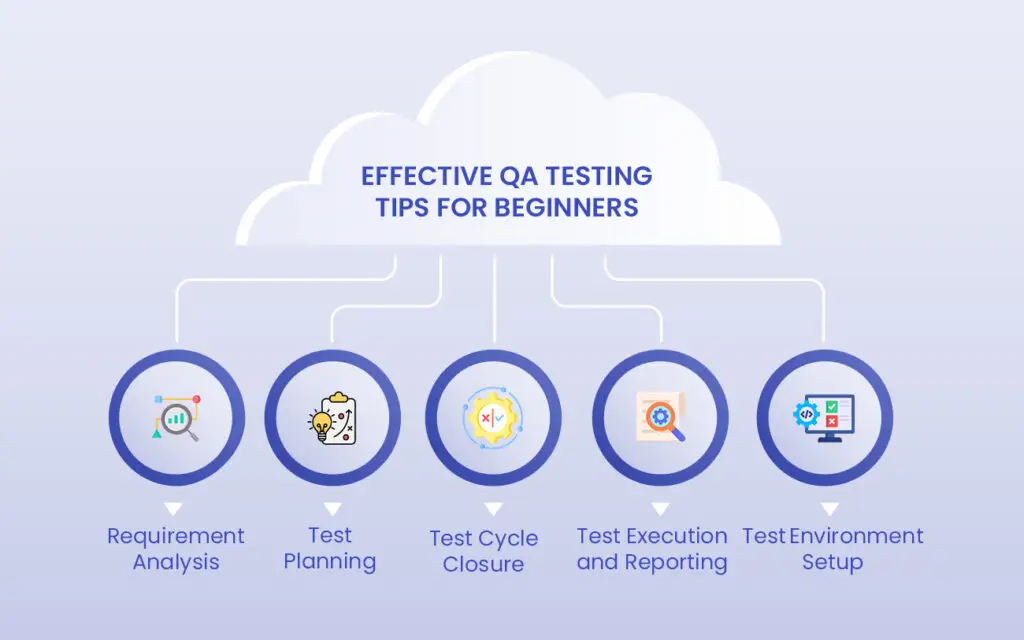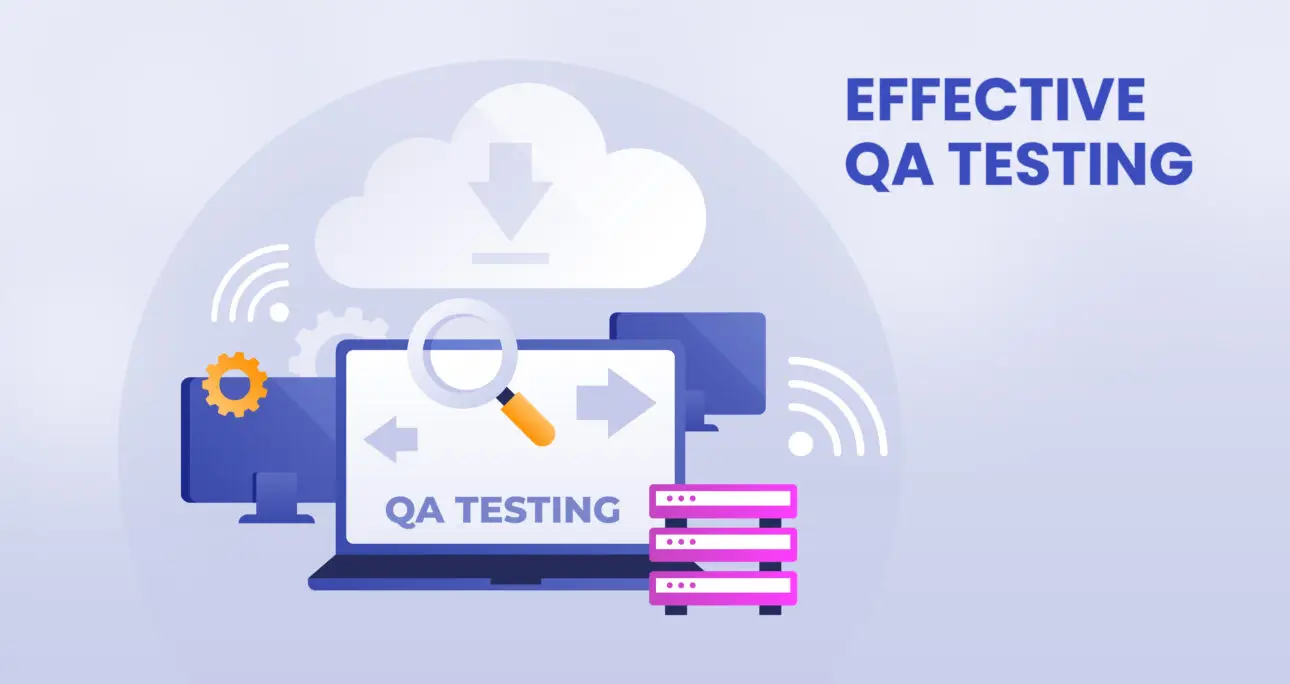In the software development lifecycle, the most important phase is Quality Assurance (QA). It provides assurance that, prior to release, the product meets all requirements and functions as expected. People who are new to this field need to understand the fundamental principles, processes, and best practices.
This complete guide will go over essential parts of QA testing, from requirement analysis and test preparation to test execution, environment setup, reporting, and test cycle closure. Whether you are entirely new to Quality Assurance or want to improve your skills, this guide will give you with practical advice to help you succeed in the field of software testing.

1: Requirement Analysis
One of the most common mistakes beginner make in QA testing is rushing right into testing without fully knowing the specifications of the product. Requirement analysis is the first step in the QA process, and it is essential for effective testing.
Why Is Requirement Analysis Important?
Requirement analysis helps determine what to test and how to analyze performance. Without a solid knowledge of what the product is supposed to perform, you will be unable to detect variations from the expected behavior. During this stage, Quality Assurance teams work with developers, product managers, and other stakeholders to obtain thorough information.
Steps for Effective Requirement Analysis
- Gather documents: Examine documents like the Software Requirements Specification (SRS) or user stories.
- Clear doubts: Please do not hesitate to ask clarifying questions about functionality, performance needs, and edge cases.
- Identify testable requirements: Split big features into smaller, testable components. For your e-commerce app, instead of simply evaluating the checkout process, break it down into particular factors such as adding items to the basket, applying discounts, and processing payments.
- Work with stakeholders: Working together closely ensures that you are testing under the right assumptions and will reduce errors in next steps.
By the end of this phase, you should have a solid knowledge of what needs to be examined, why it is required, and how success or failure will be determined.
2. Test Planning
Once you have properly examined the requirements, it is time to develop a detailed test strategy. Even though it is the foundation of any successful Quality Assurance process, test planning can be ignored by beginners. It establishes a framework for testing activities, defines the scope of work, and specifies the testing technique.
Key Components of a Test Plan
- Test scope and objectives: Clearly indicate which features will be tested, what the testing goals are, and what is the success criteria.
- Test Strategy: Choose if you will conduct manual testing, automated testing, or a combination of the two. For beginners, manual testing might be easier, but at some point understanding automation will help with repetitive work.
- Test cases: Write strong test cases for both positive and negative circumstances. A good test case contains the test input, execution stages, expected results, and actual results.
- Resource Allocation: Determine who will be assigned each task. Even in small teams, it is critical to understand who is working on certain aspects of the project in order to avoid duplication or gaps.
Benefits of Proper Test Planning:
- Minimizes risks: Planning ahead of time reduces the possibility of missing important elements during testing.
- Improves efficiency: A nicely organized test plan gets the team motivated and guarantees that testing is finished by the deadline.
Remember, thorough test planning sets the stage for seamless execution and effective reporting.
3. Test Environment Setup
Setting up a test environment is an important but frequently overlooked step. Testing in the appropriate environment guarantees that the program performs as intended when it goes live. Setting up an environment for testing can be difficult for beginners, but it is an important skill to learn.
What Is a Test Environment?
A test environment is a setting that replicates the real-world circumstances in which the software will operate. It includes hardware, software, network setups, databases, and any other factors that the program requires to run.
Key Considerations for Setting Up a Test Environment:
- Mimic the production environment: Your test setup ought to closely match the actual production environment. This includes using identical operating systems, browser versions, and gadgets.
- Use automation tools for setup: Tools like as Docker and Kubernetes can help automate environment setup, particularly when dealing with different configurations.
- Copy user conditions: Ensure that your environment will replicate a variety of real-world user scenarios, such as slow networks, variable screen resolutions, and several users working together.
- Importance of Test Environment Setup: Setting up a properly configured test environment is crucial for identifying environment-specific issues including database misconfigurations, network issues, and hardware constraints. Without this configuration, you risk missing crucial defects that appear only under specific situations.
4. Test Execution
Test execution is where all of your planning and preparation come into action. This phase consists of running the test cases you have prepared and logging the results. The execution step should be approached carefully to avoid missing anything and collect correct outcomes.
Best Practices for Test Execution:
- Follow the test plan: Ensure that you stick to the test cases stated in your test strategy. This organizes your testing and guarantees that every aspect of functionality are covered.
- Document everything: Ensure that you stick to the test cases stated in your test strategy. This organizes your testing and guarantees that every aspect of functionality are covered.
- Test in phases: Testing does not need to occur all at once. It can be divided into four phases: unit testing , integration testing system testing, and acceptance testing.
Common Challenges in Test Execution:
- Unclear requirements: If the requirements are unclear, it may be difficult to determine whether a test is passed or failed.
- Time constraints: Testing typically takes longer than expected. If time is running out, prepare to prioritize features that are essential.
5. Reporting
Another most critical aspects of QA is the ability to efficiently report issues. Bug reporting is not just pointing out problems, it is about providing clear, actionable information so that the development team can promptly resolve the issues.
How to Write Effective Bug Reports
- Use clear and concise language: Avoid technical terms unless absolutely required, and state the problem in simple words.
- Include screenshots or videos: Visual evidence can make it easier for developers to reproduce the bug.
- Prioritize issues: Not all bugs are the same. For example, a system-crashing problem is more important than a small UI misalignment. Classify your bugs based on their level of seriousness.
- Using Bug Tracking Tools: Bug tracking solutions, such as Jira or Bugzilla, are necessary for effective bug management. These tools enable you to assign problems to team members, track the status of each issue, and guarantee that no bugs fall through the cracks.
6. Test Cycle Closure
Once testing is completed, it is essential to examine every step and plan for test cycle closure. This phase involves a final assessment of all test results, bug fixes, and test coverage.
Test Cycle Closure Activities
- Review key metrics: Assess the number of tests run, how many succeeded, how many failed, and how many errors were discovered and fixed.
- Document lessons learned: Each test cycle provides opportunity to learn. Document what worked well and what could have improved for future testing.
- Prepare a closure report: Summarize the testing efforts, give statistics on testing results, and make a final judgment regarding the readiness of software’s release.
Why Is Test Cycle Closure Important?
Closing the test cycle ensures that all test objectives have been achieved. It is also an excellent opportunity for discussing with stakeholders regarding the general quality of product, any difficulties that emerged, and any remaining possible hazards.
Conclusion
Effective QA testing for beginners includes more than simply executing tests. It involves an in-depth knowledge of the project requirements, careful planning, setting up the appropriate environment, systematically running tests, and clearly reporting concerns. Following these best practices, from requirement analysis to test cycle closure, can ensure that the software you test is of high quality and trustworthy. Quality Assurance is a journey, and as you learn and grow, you will become a important member of any software development team.


